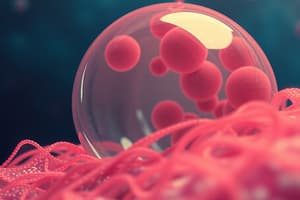Podcast
Questions and Answers
What is the basic, living unit of the body?
What is the basic, living unit of the body?
cell
What is the study of cell structure called?
What is the study of cell structure called?
cytology
What is the study of cell function called?
What is the study of cell function called?
cell physiology
Which of the following is NOT a principal part of the cell?
Which of the following is NOT a principal part of the cell?
Which cell type is known for being very large?
Which cell type is known for being very large?
The fluid mosaic model describes the structure of the plasma membrane.
The fluid mosaic model describes the structure of the plasma membrane.
The fluid within body cells is called ______.
The fluid within body cells is called ______.
Fluid outside of body cells is known as ______.
Fluid outside of body cells is known as ______.
What are the two faces of the plasma membrane?
What are the two faces of the plasma membrane?
Flashcards are hidden until you start studying
Study Notes
Cell Introduction
- The cell is the fundamental, living, structural, and functional component of the body.
- Cytology is the study of cell structure.
- Cell physiology is the study of cell function.
Cell Shapes
- A cell's shape can appear different depending on the type of section viewed (longitudinal versus cross-section).
Cell Size
- Most human cells are approximately 10 to 15 μm in diameter.
- Egg cells are exceptionally large, reaching 100 μm in diameter.
- Some nerve cells can be over 1 meter long.
- There is a limit to cell size due to the need for adequate surface area to support the cell's volume.
- For a given increase in diameter, volume increases more than surface area.
- Volume is proportional to the cube of the diameter.
- Surface area is proportional to the square of the diameter.
Cell Components
- The cell can be divided into three main parts:
- Plasma membrane (cell membrane)
- Cytoplasm
- Cytosol (fluid portion)
- Organelles (internal cellular structures other than the nucleus)
- Nucleus (contains DNA or genetic material)
Body Fluids
- Body fluids, primarily watery solutions, are essential components of the body.
- Intracellular fluid (ICF) is the fluid within body cells.
- Extracellular fluid (ECF) is the fluid outside of body cells.
- Interstitial fluid is ECF filling the narrow spaces between cells of tissues.
- Plasma is ECF located in blood vessels.
- Other types of ECF include lymph in lymphatic vessels and cerebrospinal fluid (CSF) in the meninges of the nervous system.
Plasma Membrane
- The plasma membrane is the flexible, sturdy barrier surrounding the cell's cytoplasm.
- It consists of a "sea of lipids" with proteins floating or anchored within it.
- The membrane has intracellular and extracellular faces:
- The intracellular side faces the cytoplasm.
- The extracellular side faces outwards.
- The fluid mosaic model describes its structure.
Plasma Membrane Functions
- Acts as a physical barrier between the cell's internal environment and its surroundings.
- Regulates the exchange of molecules and ions with the external environment.
- Exhibits sensitivity to the environment.
- Provides structural support.
Studying That Suits You
Use AI to generate personalized quizzes and flashcards to suit your learning preferences.




